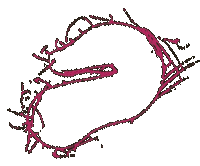October 27, 2003
palm shooter
I started another piece on Saturday. Like the last one, the wall, it was a quick decision to start. The day started out in an odd mood. It felt like a day to take a trip out to the south side to walk around and think. I went to the bookstore and walked around the mall. I found some cute foam rubber balls at the dollar store. I went to eat at Zaxby's even though I wasn't hungry. They have the best ice in town. It's the same kind you get from the Varsity in Atlanta. I took an old sketchbook in with me to look through while enjoying my beverage. Those foam balls, like the kind they use for the elastic paddle ball game, made me want to figure out a machine that I had had an idea for a week or so earlier. The idea was to present an example of a small movement experience. I just wanted to shoot harmless small objects at people's palms. The palm is the most sensitive part of the body that it is, at first glance, feasible to shoot things at. Maybe I'll do something aimed at the lips one day. Mmm… sounds fun. So, my initial hang-up was that I couldn't come up with a powered way of shooting an object that could be easily repeated with the addition of a cache of projectiles, like a paintball gun. I thought about modifying a nerf ball gun. I doubt the mechanisms would have worked out. They usually require pumping or setting stiff spring. I wanted a trigger that didn't need more than moving a lever or pushing a button. I put aside for a few days until I found those balls.
I came up with a new mechanism while I sat there. It's not new actually. Nothing I come up with could be called completely new, ever, as far as mechanics are concerned. This one works the same way a pitching machine does. A motor with a wheel attached spins over a flat surface. The ball rolls towards the wheel under the power of gravity. The ball gets caught and drawn under the wheel. The wheel squeezes the ball between it and the surface and flings the ball out the other side. Remembering that made the sculpture instantly doable. I needed something to mount everything to. I went to a sad looking Goodwill and couldn't find a table to my liking there. I went to Wal-Mart to see if I could find one there. The only one I liked was too expensive ($30), made out of hardboard (not good to mount to), and colored a pale blue (not the color I wanted). So, I went to Lowes to get supplies to make my own table.
The table is 48x24x31" (LxWxH). I built it very sturdy with exposed tie plates holding everything together. The participant sits at one narrow end of the table. Four inches of the tabletop are exposed in front of him. A 24x24" vertical divider separates him from the rest of the table. A hole is cut in the lower left-hand side of the divider, like a mouse hole. Some graphics or text on the face of the divider instructs the participant to place his left arm through the hole. He sits the heel of his hand on a padded rest on the other side as if he were making a "stop" gesture with his hand about six inches above the surface of the table. The right forearm is to be put on the table, crossing the body to find a trigger of some sort next to where the hole is (not a bob dole reference). All of the mechanisms are separated from the person by this divider. The participant can engage the trigger. This releases one ball down to the motor, which flings it to hit his palm at high velocity. I'm still playing with where I want to shot balls to collect. For the moment, I plan to just have them bounce off the hand and scatter throughout the room. The participant will be able to shoot himself several times.
I want the divider to obscure the view of what is happening. Vision seems to be the best thing to subdue when you are trying to bring out the kinestetics. Through the graphics and seeing the system before sitting down, the participant should be able to visualize how it is working in his mind. The analysis that takes place when you are forced to visualize something provides a wonderful state of mind to start from when first noticing movement. Whenever I think about a movement, I visualize at a macro scale. I'm seeing the shift in orientation of elements, the impacts, and the change in balances. Putting the participant in control facilities this. They will know when to pay attention. There is not an element of searching for what they are supposed to notice. What they notice comes up and smacks them in the palm. The surprise of the first hit can cloud the full experience. Through several shots, a deeper investigation can be made.


